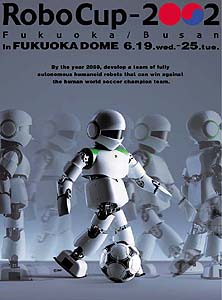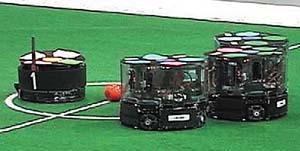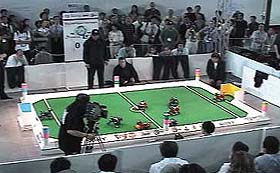Up for the (Robo)Cup
Back to Contents of Issue: August 2002
|
|
|
|
by Alex Stewart |
|
 JAPAN HAS A DREAM that in 50 years it can field a team of robot players capable of winning the World Cup. In fact it is already taking steps toward that dream. The sixth RoboCup Competition was held in Fukuoka, Japan, and Pusan, South Korea, between June 19 and 25, preceding the real thing, and with a crowd turnout of around 125,000, the organizers fared better than FIFA's World Cup ticket agencies. JAPAN HAS A DREAM that in 50 years it can field a team of robot players capable of winning the World Cup. In fact it is already taking steps toward that dream. The sixth RoboCup Competition was held in Fukuoka, Japan, and Pusan, South Korea, between June 19 and 25, preceding the real thing, and with a crowd turnout of around 125,000, the organizers fared better than FIFA's World Cup ticket agencies.I went on a quest to track down the source of this whacky project, and discovered Minoru Asada, a 48-year old professor at Osaka University's department of adaptive machine systems. Here is a dreamer you could say, in an ivory tower, having never left the campus of Osaka University since he was an undergraduate student in the 1970s. However, he clearly travels far in his mind and as he talks his eyeballs give the impression of Astro-travel, swiveling excitedly as his enthusiasm for all things robotic mounts. Robots are in the Japanese blood he explains: "We can accept robots as partners in our life." He cites the major influence in his own life of the writer and manga artist, Osamu Tezuka (a fellow graduate of Osaka University) who brought robots to life in a love story called Fire Bird. Fantastic in some ways, it is not necessarily more extraordinary than traveling to the moon. Put in a cultural context, Americans and Russians have souls to dream about reaching the stars, while Japanese have a deeper relationship with the earth, and dream about breathing 'life' into robots. The notion of tin footballers playing flesh and blood human beings seems unlikely, but the research that Asada and many others are undertaking is already working on the more delicate issues involved in machine-human competition. To bring machines to life requires much more than engineering; it requires an understanding of human beings, including everything from emotions to sociology. For example, robots will have to acquire sensory skills in order to play soccer in a socially acceptable way. The fact that robots are currently not 'sensitized' is a problem that prevents them from entering real work environments, such as hospitals, due to patient liability concerns. In the football context it could spell disaster if a robot going head to head for the ball cracked skulls with its opponent. To level the field therefore, work is going on to develop soft robot body suits with sensors inside, which communicate when the tin man is hurting himself, thereby reducing the risk of serious damage to his opposite number. But this is just the tip. If researchers are really going to make robot soccer so lifelike that a team can compete in the 2050 World Cup they will need to pull together a host of disciplines. The scale of the task is enormous, involving cognitive psychology, speech, vision, genomics and sociology to name a few. Taken together this is broadly defined as artificial intelligence (AI). Using soccer as the context to bring these AI fields together is crazy, but brilliant. Herbert Simon, a pioneering figure in robotics and machine learning, commented in one of his last lectures before his death "that almost all of our hopes and concerns for the future can be examined in miniature in this setting [of robot soccer], including our own role in relation to computers." Not mentioned though is that the best ingredient of all in this mix is simply having fun doing it.  Fun is not an idea normally associated with Japan, yet it was essentially the earnest Japanese who invented robot soccer. Before this, Asada explained, the AAAI (American Association for AI) was running robotic competitions which required huge amounts of computational energy for robots to solve. It was one of Japan's most creative engineers and scientists, Hiroaki Kitano, who had the idea of making the competition fun by imitating the world's favorite sport.
Fun is not an idea normally associated with Japan, yet it was essentially the earnest Japanese who invented robot soccer. Before this, Asada explained, the AAAI (American Association for AI) was running robotic competitions which required huge amounts of computational energy for robots to solve. It was one of Japan's most creative engineers and scientists, Hiroaki Kitano, who had the idea of making the competition fun by imitating the world's favorite sport. At the 1993 International Joint Conferences for AI, where he had just received the Computers and Thought Award, Kitano announced his idea for a robot soccer game. It happened that 1993 also marked the year that the J-League was launched, so soccer was a current theme in the media. The first idea on the Japanese side was to call it Robot J-League, but foreign researchers objected to the exclusively Japanese association. It was evidently Asada who then came up with the name which stuck -- RoboCup. He was reluctant to take all the credit though, pointing out that a professor at the University of British Columbia, Alan Mackworth, had also proposed something similar around the same time. However, Asada's research group was already playing robot soccer in their labs before the game idea was mentioned by Kitano. To this extent, there is a suspicion, which Asada would not confirm, that Osaka University is the birthplace of the sport. Whether this will lead to robo soccer fans in the future making pilgrimages to the Suita campus in the lush foothills above Osaka though is a bit too early to tell.  Currently, the excitement of robot soccer resides more in overcoming the technical challenges than in the smooth flow of play. The field comprises an area about half the size of a basketball court in the most popular Mid-Size League game, in which four robots compete on either side. Until this year a low barrier kept the ball in the court. Now, there is no barrier, so robots have the added challenge of keeping the ball in play. The game lasts 10 minutes each way, with a 10 minute break for fine-tuning parts. The scorecard is generally the same as in a real soccer game. However, scoring goals is not the only test of competence. Teams also have to submit research papers, just as they would at an international research conference. These are judged by committees who award prizes based on the papers as well as the scores.
Currently, the excitement of robot soccer resides more in overcoming the technical challenges than in the smooth flow of play. The field comprises an area about half the size of a basketball court in the most popular Mid-Size League game, in which four robots compete on either side. Until this year a low barrier kept the ball in the court. Now, there is no barrier, so robots have the added challenge of keeping the ball in play. The game lasts 10 minutes each way, with a 10 minute break for fine-tuning parts. The scorecard is generally the same as in a real soccer game. However, scoring goals is not the only test of competence. Teams also have to submit research papers, just as they would at an international research conference. These are judged by committees who award prizes based on the papers as well as the scores.There are up to 10 different leagues in which teams can compete. They include the Mid-size, Small-size, Sony Aibo and Humanoid League. Osaka University's specialty is the Mid-Size, which stipulates a robot size of 60cm in height and less than 45cm in diameter. The Osaka team comprises nine graduate researchers -- two-fifths of Asada's research group. It won the first competition jointly in 1997 and placed second in 2001. The team's other distinction is to be the only one to have competed in every competition. This year in Fukuoka 188 teams from about 29 countries competed in the different leagues, with over 60 percent coming from outside Japan. The essence of a successful robo team is one that can be taught how to work together, locate the ball, control it and determine strategies for scoring goals. The skills which robots need to achieve this are central to Asada's research, which he describes as "modeling learning processes." He points out that he wants to "use research on robotics as a test bed for human research in general." He adds that no one imposes a research objective other than developing robots smart enough to co-operate and win a game. Osaka University is an ideal research location for developing a multidisciplinary project of this kind, being probably the leading center of research in Japan for both advanced materials engineering and bio-medics. In recognition of this, Osaka along with the University of Tokyo are the only two centers in Japan to receive funds under the Frontier Research program launched by the Ministry of Education, Culture, Sports, Science and Technology at the beginning of this year. Asada's RoboCup team is one of five projects at Osaka University funded under the program. It allows him to convene off-site brainstorming sessions with researchers in different fields to help push back the frontiers of research together. An important threshold was crossed at the sixth RoboCup Competition, which featured the inauguration of the Humanoid League. Humanoids, Asada says, are the "final goal," but he cautions against expecting too much. The judging would revolve around their competence in freestyle events, such as standing on one leg for a period of time or performing a dance routine. He acknowledged that as robots become more humanoid, their range of uses has not advanced. No one for example has found a real application for Honda's Asimo, which walks about on two legs like a human -- its current claim to fame is merely that it was the first robot to ring the bell of the New York Stock Exchange. Beyond the novelty and entertainment value, the real goal for researchers like Asada is to model human intelligence. If they are successful, we can expect machine servants and companions within a generation. If so, robo soccer could become a stress antidote for humans and robots alike, since every four years robots will have the chance to restore the balance of respect in the relationship by winning the competition. Should this really come off the page of what currently sounds like science fiction, Japan may claim it has invented a world sport, which, like the Olympics, builds goodwill between peoples, but the bridge this time will be between machines and human beings. @ Alex Stewart is a contributing editor at J@pan Inc. His latest article, More Japanese than the Japanese, an interview with Ashisuto CEO Bill Totten, appeared in July 2002. |
|
Note: The function "email this page" is currently not supported for this page.





